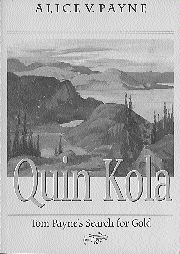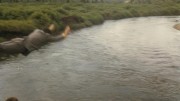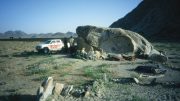— The following is the first of three excerpts from Quin Kola: Tom Payne’s Search for Gold. The book is published by Crossfield Publishing in Okotoks, Alta. Copies are available for $25 at CSPG.org or by calling (403) 286-1816. The author is Alice Payne, daughter of Tom and president of Calgary-based Arctic Enterprises.
q Alice Payne — “For most bachelors, seasonal work on farms meant that winters were spent elsewhere. The country north of The Pas was the natural place to go. Prospectors had started out looking for gold, thanks to a Geological Survey of Canada report in 1896, but instead they found the large base metal deposit at Flin Flon, which remained unminable until the engineers figured out how to refine the ore.
“Construction started in 1927, with a mill, copper smelter, zinc refinery, and the necessary infrastructure. About a hundred miles beyond there, the Sherridon copper-zinc mine, discovered in 1922, was close enough to the ‘end-of-steel’ to be economical. All this activity spurred more development.”
q Gordon Willsie (prospector) — “I went to The Pas in the spring of 1923 and then prospected the country around Flin Flon and Herb Lake. Conditions at The Pas were lively, with Indian dances and considerable frolicking.
“For five years I was the official timekeeper of the famous two-hundred-mile Dog Derby races. My father-in-law, Louis Allard, the teamster, worked for Tom, hauling freight. He was well-known up there during the twenties.”
q Jack Moar (bush pilot) — “When the preliminary work was being done at Flin Flon, Hudson Bay Mining & Smelting needed a man to operate a shovel. Tom could run both steam- and gas-powered engines, and was recommended by the contractor to scrape overburden from the future mine site. Along with the muskeg, he dug a pit out of an orebody. Every shovel bite was worth more than a $1,000 because of the gold content. This is what really inspired his interest in mining.
“All freight hauling was done with sleighs on winter ice roads. Men on snow shoes with dog teams began construction in the fall. When the trail was ready, horses and sleighs pulled water tanks over it, gradually building it up enough for tractors to support heavier freight. They constructed an ice road from The Pas to Flin Flon some thirty-five feet wide and three feet thick, complete with marshalling yards, turnouts, halfway houses and electric lights.
“Linn tractors were the main pieces of equipment. They looked something like a truck on skis or a skidoo, with tractor treads behind, and could pull more than they carried. Tom signed on as a driver and worked for Harry MacLean, the flamboyant contractor who pioneered the Linns in northern exploration. MacLean later became famous for throwing money out of Toronto hotel windows.”
q Tom Payne — “At Island Falls, I met an old Russian living on the Churchill River who made lovely caviar. He was a real expert. He’d once made it for the Czar and knew how to pickle-smoke the sturgeon roe. His only trouble was a lack of containers. So I gave him six empty forty-five-gallon oakwood barrels plus some company beef. In return, I got a barrel of caviar for R.E. Phelan, the president, who wanted to pay me for it. But I had to confess how I got it, and he got a big kick out of that.”
q Alice Payne — “The hydroelectric plant at Island Falls required sixty miles of transmission lines, and a branch line connected the minesite to the railway. The freight haul to the site was a big job: 23,000 tons of heavy materials had to be transported over sixty-nine miles of terrain before winter’s end. One forty-hour, nonstop, round trip consisted of 11 Linn tractors, each pulling sleds. There were five road gangs along the way, and strategically placed water trains to ice the portage and keep the roadbed smooth. The record for one trip was a hundred and twelve and a half tons, although the average was eighty-five.
“Typically, one load of consisted of cement, contractor’s equipment, extra gas, wire and steel, lumber and a thousand tons of provisions to feed eight-hundred men for one year. In other words, four-hundred and fifty-thousand pounds of beef and fifteen-thousand eggs, or half an egg per man per day. An ammonia plant kept the food frozen, and the power plant ran the camp. All this material was hauled in during the winter of 1929.
“Thayer Lindsley, an American who had brought Sherritt Gordon mines into production, sent his prospecting organization, Dominion Explorers, into the far north on an imaginative task. Led by Lieutenant-Colonel C.D.H. MacAlpine, a Toronto mining man, they expected to move men and supplies to a base at Tavani, an Inuit village three-hundred miles north of Churchill, and from there, conduct work around Rankin and Chesterfield Inlets, Baker Lake, and the Dubawnt River.
“To quote The Northern Miner, they were to ‘seek out and co-ordinate the coming season’s work of a score of prospecting parties, ascertain winter conditions, exploit the company’s advantage of having wintered on the ground, and generally review the far-flung northern prospecting situation.’ A caterpillar tractor train carrying supplies was sent from Flin Flon, and a two-plane scouting expedition was sent out on the first of two trips.
“On March 25, 1929, pilots Stan MacMillan of Edmonton and Charles Sutton of Toronto left Ottawa for Churchhill, Man., with two Fairchild aircraft. They carried a thousand and six-hundred pounds each. On board were MacAlpine, Norman Pearce of The Miner, a geologist, a New York camera man, a mechanic, a wireless expert, and a troubleshooter.
“The well-publicized flights — four-thousand miles for one plane and six-thousand miles for the other — turned out to be the longest winter air trips made in Canada at the time.”
q Victor Stevens (prospector) — “I was introduced to Tom at Tavani, Man., which Inuktitut means ‘up there in the north.’ I was with Dominion Explorers and they conceived the idea of freighting us our supplies by tractor.
“Unfortunately there was a heavy flow of water on the sea ice, covered by a thin ice coating. The tractors got bogged down and were unable to proceed. Tom was one of the drivers.
“Wages were five-hundred dollars per month, including board, which was good pay in those days! In order to qualify for the job, every Cat skinner had to be capable of taking a Linn Cat apart and, if necessary, rebuilding it. I set out with Harry MacLean’s outfit from Flin Flon on the Hudson Bay Railway, to the end-of-steel at Nelson River. It would take four years of work to extend the line right to the coast.
“Along the way, the Russian and European immigrants rode in the boxcars. How they sang! Every verse ended with ‘God bless the CPR.’ For many, that was the only English they knew. The train would slow down somewhere in the barren lands, and a man would yell for six guys to get off at intervals of about five-hundred feet. Any six, mind you.
“They would jump into the snow with their bundles of clothes and grub, followed by stoves, wheelbarrows, picks and shovels. By the next the day they would have built a shelter out of muskeg, snow and mud, and baked the loveliest buns you ever tasted. Soon they’d be working, digging puddle ditches alongside the track — all for seventeen and a half cents an hour and often in forty to fifty degrees below. It made me wonder about the conditions they’d left behind in their own countries.
“From Nelson, we assembled the sleighs, loaded the freight and set out for Churchill and Chesterfield Inlet. The trees thinned out and became scrubby, with their tops just poking through the snow under our treads. No wonder the Eskimos called it ‘the land of little sticks.’ There was no protection against the wind, and we suffered terribly until we got some fur-lined coats.
“The main thing was to get up right away in the morning and shake the frost off your sleeping bag before it melted. If you got it all off, then you were alright; if not, then you iced up.
“On our arrival at Churchill, the military commander forbade us to enter inside the long wire fence that surrounded the place. We had one hell of a row over it. I asked how far and how tough it was to get around that damn palisade. Since we had come two-hundred and fifty miles, a few more steps made little difference.
“We were just getting ready to detour around when a dog team arrived with a telegram from Ottawa. It read: ‘PLEASE RENDER THE MACALPINE EXPEDITION EVERY ASSISTANCE.’ In we went. We were put up in the staff house and fed and liquored in the officer’s mess. The army Cats were pulled out of their garages and parked in snow banks while ours were greased and serviced. Heaven!”





Be the first to comment on "Odds ‘n’ Sods: Tales of Hudson Bay"